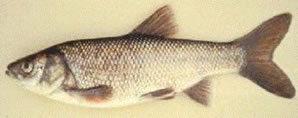
Invasive species have become a serious problem in south central Oregon’s popular Diamond Lake and could potentially impact the excellent trout fisheries. The Oregon Department of Fish and Wildlife (ODFW) will be trying something new…add one new fish to remove two unwanted ones. Within the next two weeks, tiger trout will soon be swimming in the lake’s clear waters in the hopes that these sterile trout will prey on the unwanted tui chub and the golden shiner, that could potentially take over the lake.
The invasive fish were inadvertently introduced to Diamond Lake by fisherman, who use shiners and chub as live bait. Once in residence, these rapidly reproducing fish, compete with native species and with the rainbow trout sought after by local fisherman. Both shiners’ and tui chubs are minnows that spawn at smaller physical sizes and prefer to hang out in large schools close to banks. Scientists hope that the tiger trout will take advantage of this and feed on the unwanted fish who reside in the shallows.
Tiger trout are a hybrid between a female brown trout and a male brook trout. They will grow to lengths well over 12 inches but will not be able to reproduce. ODFW was able to purchase the trout from a private hatchery in Utah, the Cold Springs Trout Farm, through grant funding from the U.S. Fish and Wildlife Service (Service).
“We all felt tiger trout were the way to go,” said ODFW District Fish Biologist Greg Huchko. “Because these fish are sterile, there isn’t a risk to North Umpqua River native fish. And once they’re about 14 inches, they should begin to prey on golden shiners and tui chub.”
In early June the plan is to initially stock 5,000 fingerlings (between 5 – 7 inches in length) into the lake. Later in the month, another 13,000 will be added. Over the summer, they will monitor the tiger trout by taking creel surveys and diet samples. Technicians will also be removing golden shiners and tui chub via beach seines, fyke nets, trap nets and electro-fishing. Scientists believe this effort will improve the health of the lake and provide more angling opportunities for the popular Diamond Lake rainbow trout fisheries – where the growth rate is a phenomenal one inch per month, over the summer months.

Back in 2006, ODFW attempted to eradicate these troublesome species by treating Diamond Lake with rotenone. After ridding the lake of an estimated 90 million tui chub, they thought they had solved their problem. Then in 2008, biologists discovered golden shiners, another illegally introduced bait fish. While conducting routine monitoring last fall, scientists discovered a single tui chub, requiring ODFW to rethink their eradication efforts.
Diamond Lake Rainbow trout fishing is excellent right now and the fish are biting well. Later this month, ODFWS will stock 300,000 rainbow trout fingerlings in the lake that should be of legal-size by this fall. However, if you catch them now be aware, the limit is five legal-sized (eight inches or longer) trout per day with two daily limits in possession and just one trout per day over 20 inches. Tiger trout angling is catch-and-release only.
The Diamond Lake project is an excellent example of Federal and State Governments working together to provide the best possible recreational fishing opportunities for the American public. Partnering with the Umpqua National Forest, Oregon Department of Environmental Quality and Douglas County, ODFW has formed a joint action plan for managing Diamond Lake and its fishery. This plan includes a fish monitoring and a fish stocking strategy.
The Service’s Wildlife and Sport Fish Restoration provides partial funding for projects like this from excise taxes on purchases of fishing equipment, motorboat and small engine fuels. These funds go a long way towards conserving, protecting and enhancing fish, wildlife, and their habitats. To learn more, go to http://wsfrprograms.fws.gov/Subpages/AboutUs/AboutUs1.htm
